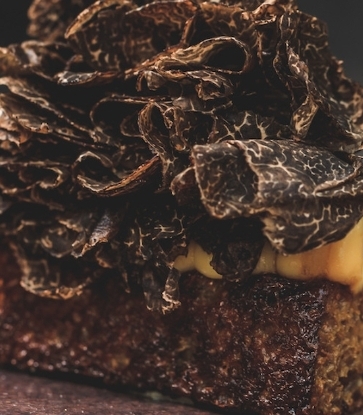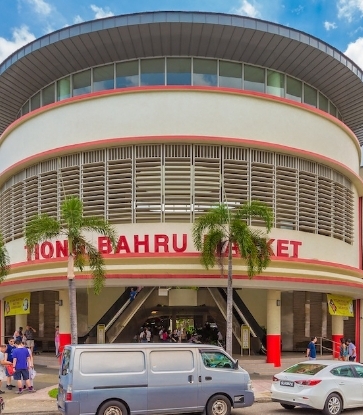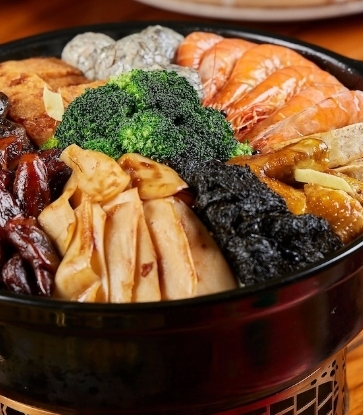Three evenings later, the red ants are tenderly spooned on mochi rice ice cream just before being placed on a diner’s table. The squeamish might shriek and run but the adventurous would later savour the beautiful contrast between the ants’ tangy lemon crunchy texture with the dessert’s creamy flavour.

Cynics would call the idea a gimmick. After all, Singapore is a concrete jungle heaving under the weight of 5.3 million residents. There’s barely any space for farms, much less edible wild ingredients.
Still, the idea of eating wild harvest is by no means new. Bjorn Low of Edible Garden City is one such proponent – and that’s not forgetting the hobbyists who line our shores with fishing rods in search of a good catch.
What’s new here is that these two chefs have the guts to do it at the restaurant level. On the cards: Lewis and the owners of Tin Hill Social are toying with the idea of starting a full-service restaurant in Singapore that showcases foraged ingredients – never mind the immense logistical and legal challenges it poses.
For starters, wild-caught animals are not allowed to be served in the commercial space, so line-caught fish or clams dug out from the coasts are out of the question. Foraging in national parks and reserves too is not allowed – and these spaces are home to edible herbs like lemongrass, pandan and even fruit trees like rambutans and mangoes.
There is also the challenge of getting enough types and amounts of wild edibles to create a decent menu to feed all the diners for every single service. The big question: is foraging a viable concept and can a restaurant of this nature actually work in Singapore?

The two chefs are not the only ones to execute such a concept. In 2014, chef Dave Pynt of Michelin Guide-listed restaurant Burnt Ends held a one night only dinner which used foraged ingredients – though most of it was mainly as garnish rather than embedded into a dish’s DNA.
Chef-owner Sam Aisbett of contemporary Australian restaurant Whitegrass is also in talks to engage a forager to create a menu that combines native Aussie ingredients with local wild edibles.
These overtures point to a restaurant trend in its nascence, taking the mantra of locavorism – or eating local produce – to the extreme.
Indeed, the focus of chefs have lately pivoted towards cooking locally grown produce, as Singapore does have its own egg, goat milk, fish and vegetable farms.
At the practical end, it’s a sustainable practice. The produce travels less, utilises less energy in production and arrives fresher. At the romantic end, it’s about savouring the terroir of Singapore.
“Before I came, people were telling me that, “oh Singapore’s so small and you’ll find nothing there,” says Holland on the city’s non-urban spaces. “But when I arrived, there’s jungle everywhere I looked – and we’ve found so much without even venturing further out.”
The pair scoured the wilderness of Dempsey Hill, Bukit Timah, Kranji, and even went on a daytime jaunt to Saint John’s Island. Their haul over a course of two weeks’ worth of foraging was a grocery list of at least 20 edible wild finds.

And those are only the ingredients they’re cooking with. Other edibles they found included tapioca and Asian pennywort, which they had to leave out of their menu.
Lewis believes the key to their foraging success is the amount of research they did before starting, including enlisting the help of Bjorn Low before Holland arrived.
“Bjorn took me first around Dempsey. I also did a whole day tour in Kranji, just around the farms,” says Lewis.
Low also introduced them to books, like 100 Useful Herbs of Malaysia and Singapore which lists their culinary and aromatic uses. Many of the botanicals are listed under their Malay names, and traditionally eaten as raw salads known as ulam, which is composed of natural greens with flavours so punchy that dressing is not typically needed.

Unsurprisingly, most of the foraged ingredients are already part of Southeast Asia’s culinary repertoire – yes, including the ants.
In landlocked Laos and parts of Thailand, the eggs, larvae and pupae of weaver ants are a delicacy and mixed into salads (known as Jam kai mot dhaeng in Thai) or cooked in soups. The eggs have a milky taste while the ants add a tart dimension to the salad.
Many of the greens, meanwhile, are common components of ulam, while wild pepper leaves are usually eaten as a substitute for betel nut leaves.
These ingredients and its associated flavours are not what one would find at restaurants and eateries today – not even at traditional establishments nor wet markets. As Singapore industrialised, farms and wilderness gave way. People moved out of kampongs – the villages in proximity to nature – and into HDB flats. As environments changed, so too did diets. Traditional ulam has become increasingly rare as many of the herbs and botanicals that go into them are not being commercially produced. The closest to find them geographically would in fact be at Malaysia’s farmers’ markets.

Still, these unfamiliar flavours do not faze Holland nor Lewis. In fact, the promise of rediscovering lost flavours is arguably the most exciting frontier of foraging in the Singapore context, especially when tested against a chef’s palate.
“A lot of it goes back to the basic taste senses: salty, sour, sweet, bitter,” says Lewis. “It’s really all about cutting back to the basic taste structure and pairing things together.
“For us, what we do is we taste it first, and then we see if it deserves to be cooked, raw or better pickled,” says Holland. “It’s all about experimenting; that’s how chefs have always cooked.”
Many of the dishes they plated up had dimensions of flavour unseen in other restaurants.

Other ingredients were used in surprising ways. Take for instance, the quail stuffed with curry leaves served with figs and ricotta cheese on the side. While the quail sourced from Uncle William’s farm veered on the tough side, the figs were poached with kelp caramel and sugar cane juice. The ricotta cheese, meanwhile, was made by coagulating goat’s milk from Hay Dairies Farm with the sap of the fig tree branches.
Besides main elements on a plate, the chefs created seasonings out of both farmed and foraged ingredients. There was the coconut salt used to season the raw kelong prawns made from reducing the coconut water of fresh coconuts as well as sea water from St John’s Island. This was followed by a serve of the blue flower crab garum, made by fermenting the crustacean and then filtering it to achieve a brown liquid that tastes like fish sauce but with the unmistakable flavour of crab.

The clever use of ingredients is all well said and done, but can an actual foraging-focused restaurant survive in terms of quantity of food served? Their three-night dinner after all, served a maximum of 180 people.
“If we keep the restaurant small, without a doubt, yes,” says Lewis. “I'm thinking of a restaurant with maybe 25 seats. Even now, when we foraged for 60 persons per dinner, we picked enough butterfly pea flowers last week to last all three nights. We came back to the same place yesterday and saw new ones in bloom already.”
The key is not to decimate the entire population, the chefs highlight. “Each time you pluck something, the plant regenerates itself,” says Holland. “And if you’re smart about how you cook and serve it, one day’s worth of foraging can actually last you a while, especially if you’re poaching or pickling.”
The restaurant would also have to hire at least one full-time forager to keep the supply levels for the restaurant going.
“It’s going to be a lot of work,” concludes Lewis.
Which is possibly what anyone who’s laboured over a novel idea would say.
Recommended Reading: View all Singapore stories here























